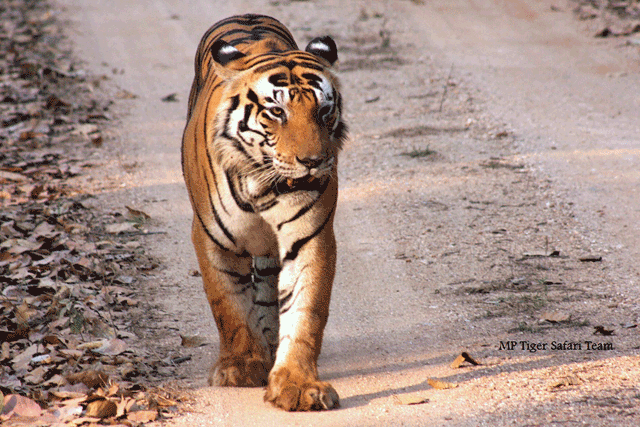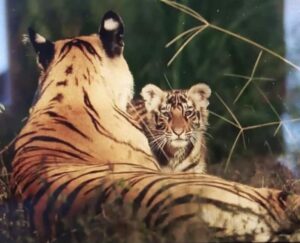Bandhavgarh is a very popular national park in India as it is well regarded for having huge density of tigers. Bandhavgarh National Park is believed to have world’s highest density of Bengal Tigers. It also has rich diversity of flora and fauna to attract nature and wildlife lovers. From Chinkaras to Bisons and Nilgais grazing on the grasslands, Bandhavgarh houses a huge range of animals.
There are three core zones in this national park – Tala, Khitauli, and Magadhi. The park is stretched over 694 sq. km in total.
Fauna in Bandhavgarh
When you start exploring the dense jungles, you can easily spot the amazing fauna species like Chausingha, Nilgai, Chital, Langurs, Chinkara, Macaques, Muntjac, Jackals and Wild Boar. You can find different butterflies and birds which belong to the wildlife of Bandhavgarh. Nature lovers can explore the thick and dense forest regions of the national park and is well known for varied range of plant life and wildlife and is well regarded for varied topography.
Tigers \Tigers are the heart and soul of this national park. There are also epic stories and tales regarding the tigers here, such as the story behind Charger, a popular tigress once known for her aggressive behavior.
Leopard
You can find leopards mainly in the core area. But they are also found in buffer zone. They are quite smaller than tiger and their favorite prey are spotted deer, barking deer, chinkara, wild boar, langur, and livestock.
Sambar
Another famous mammal which can be spotted easily here is Sambaar. They are the largest deer in Asia which can weigh up to 350 kg and around 150 cm high up to their shoulder. You can spot sambar only in the dense grasslands and canopy of the jungle. These antlers re-grow during the month of March and April.
Sloth Bear
As the name suggests, Sloth bear is like a mixture of bear and sloth. Its diet mostly depends on vegetation and mahus fruits and honey are its favorite. As compared to arctic bears, they are relatively small.
Barking Deer
They are relatively smaller than Sambar and Chital and are found basically around water bodies. As the name suggests, they are used to call alarm sounds like a dog is barking. They are pretty good at camouflage in the bushes whenever it feels any threat.
Chital
Also known as Axis Deer, Chital plays a vital role in ecological balance. The vegetation these mammals eat has great chances for survival as they are very fertile by nature. Their antlers are mostly detached once mating is done whenever monsoon season arrives. During winter, female mammals give birth to one or two fawns.
Langur
They are easily found in temples and rural areas, along with jungles. They are usually found in groups and they bound well with spotted deer. Both tigers and leopards prey on langurs.
Wild Dogs
Also known as Dhole in Central India, wild dogs also communicate by whistling along with barking. They are very flexible and are used to eat their prey alive.
Wild Boar
In Bandhavgarh National Park, some wild boars were brought from Kanha National Park. They basically live on hills and come to the plain or downhill to have water and feed grass. They live in herds of cubs, females and other adult males. As compared to males, females are smaller and the size of the group can have up to 40 wild boars. Their mating season starts from winter. Later on, they live alone with a few male wild boars.
Flora in Bandhavgarh
Bandhavgarh is known to be rich in diversity of flora thanks to the combination of different types of soils and landforms and the region remains very moist. Bandhavgarh is known to have Southern tropical moist deciduous and Moist peninsular sal forest, as well as Southern tropical dry deciduous forest. It has over 50 aquatic plant species, 600 flowering plant species, and 18 rare plant species. You can find different trees in the national park, such as –
Sal Tree
This timber tree is found all around the tiger reserve. It is a slow and moderately growing tree and is found highly in the forest. Its anti-termite wood is widely used in making railway sleepers and furniture. The viscous paste (gum) releasing from its stem is used in marine yards and for making shoe polish. It is almost an evergreen tree.
Mahua (Indian Butter) Tree
It has been used in villages for ages in Central India. Oil which comes out of its seed is widely used in soap industry as edible oil. Its fleshy flowers are high in sugar, calcium and vitamin for animals and birds. Local villagers also use its flowers to brew a strong alcoholic drink.
Saj Tree
There are 200 species of shrubs and trees in the Terminalia Linn. It is a rich source of non-wood products, such as drugs, oil, and gums. It has unique patterns on the bark due to which it is known as crocodile bark tree.
Palash Tree (Flame of Forest)
It is well known for vivid orange flowers which come in full bloom in February. Its flower is boiled and its color is used for making ink and dye.
Stone Apple (Bel)
The outer crust of its fruit is very hard. Due to this reason, it is known as stone apple. Its juice is extracted to make healthy drinks to soothe all the problems of stomach like constipation and diarrhea.
Banyan
This tree grows as a very giant tree which is stretched over several hectares. Its figs are good for mammals and birds like Indian mynas. According to the studies, the seeds which pass through its digestive system are known to germinate.
Bottom Line
So here are some of the rich flora and fauna in Bandhavgarh National Park you should know. If you are planning to visit there next time, be sure to expect seeing these attractions.







